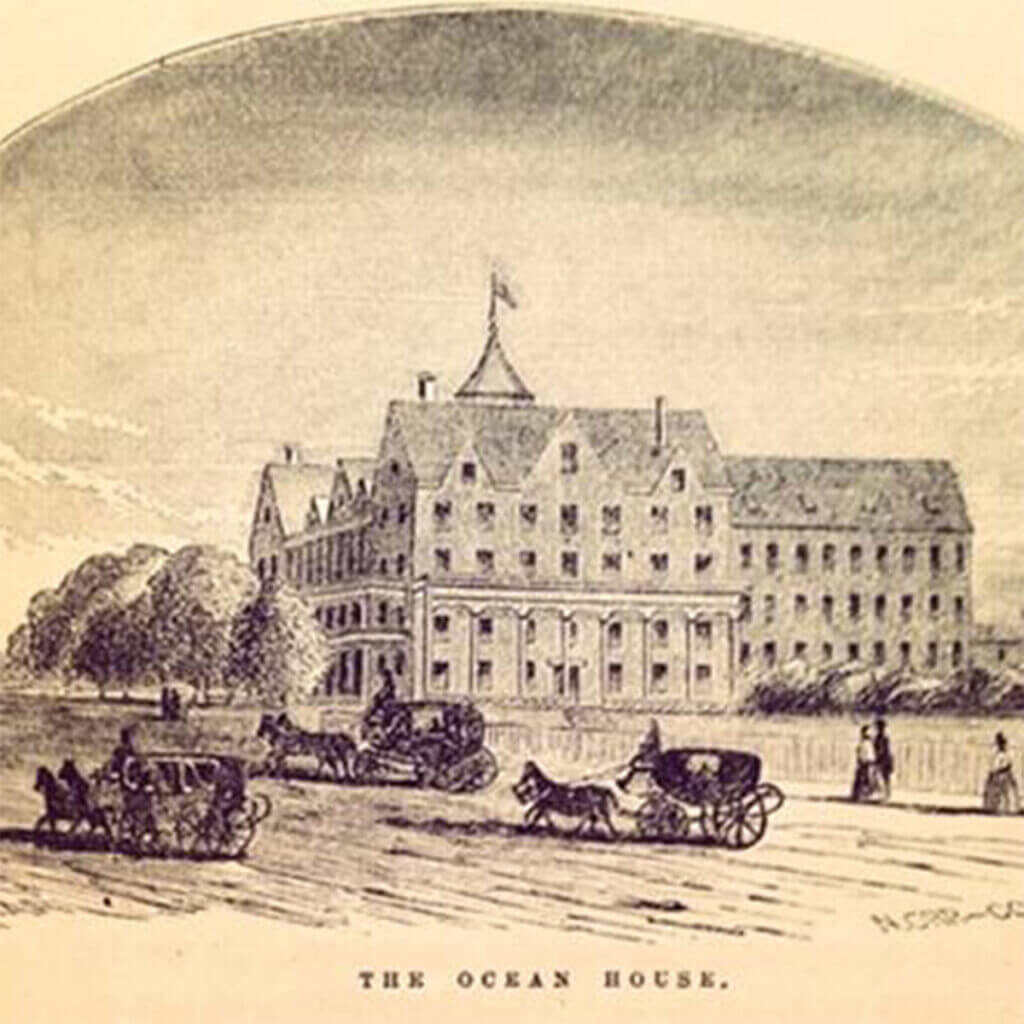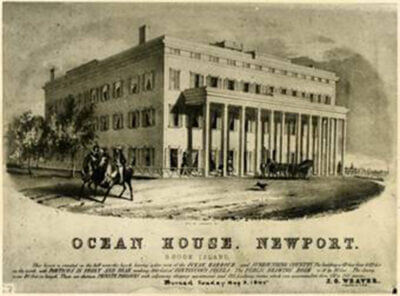Even in the midst of the COVID-19 pandemic, Newport is in the middle of a building boom with multiple hotel proposals before the various boards and commissions of Newport and Middletown and two new hotels, Hammett’s Wharf and The Brenton, have just recently opened along America’s Cup Boulevard. Newport’s reputation as a Gilded Age resort is world renowned and the Newport name came to embody elegance, resort charm, and luxury. But where and when did the reputation first begin? In fact, the present day is by no means the first time that Newport has become a focus for new hotel construction. In the middle of the Nineteenth century, Newport was one of the earliest resort communities where large, grand hotels were built to accommodate both tourists and the guests of summer residents.
One of the grandest hotels of Newport that is no more was The Ocean House, originally constructed in 1840. The building, rather than being on the Ocean as its name might suggest, was actually located on the corner of Bellevue and Bowery, on the location which currently houses the offices of Smith Barney.
This structure was originally a four-story structure built in a severe version of the neo-Greek revival style typical of much of the residential construction of the period. The building stood as a gateway to the southern part of Newport that was just beginning to blossom along the length of a newly developed Bellevue Avenue.

After only five years the original hotel was destroyed by fire and a new, larger building was constructed in its place. The second hotel was designed by noted architect Russell Warren in the Neo-Gothic style, which was rising in popularity and better suited the larger reconstruction. This style allowed for a series of steeply sloping gables along its two primary facades which gave it both height and grandeur as etchings of the period convey. According to an advertisement of the period, the hotel boasted “A fine view of the Ocean Harbour and Surrounding Country. The building is 112 feet front & 125 feet on the north. With Porticos in front and rear, making 300 feet of continuous piazza. The public drawing room is 51 by 20 feet, the Dining Room 30 feet in length, and there are thirteen private parlors with adjoining sleeping apartments and 125 lodging rooms which can accommodate 150-200 persons.” This second hotel operated and prospered until 1898 when the rebuilt structure was also destroyed by fire, which was a great threat to buildings in the time before sprinklers and modern construction methods.
The other hotel that vied for primacy in Newport during the middle Victorian period was the Atlantic House, which was built on the intersection of Belleview and Pelham Avenues, overlooking the Newport Tower. This site is where the Elk’s Lodge and its parking lot currently sit. The building, perhaps taking its queue from the Redwood Library which it faced across Touro Park, was designed in a neo-Classical style with a large, six-column pediment dominating its front façade.
These grand hotels were the early centers of culture and social activity for Newport. As the seasons passed, the Atlantic House grew in popularity. The hotel often partnered with the surrounding proprietors to employ musical talent and provide entertainment. It hosted “hops” and fancy balls for guests, and it presented lectures and provided conference space for visiting businessmen and townspeople.

In 1861, with the outbreak of the Civil War near Annapolis, the Naval Academy was moved to the site of the Atlantic Hotel, where it was safe from the threat of Confederate invasion. The Academy operated within the structure until the conclusion of that conflict in 1865 and a sign on the Elks lawn commemorates this period in Newport history that may have contributed to and presaged the location of the Naval War College here in Newport in later years. Following the war, the owners of the building needed to jump start its use and in July 1866 the hotel contracted with James. L. Plimpton of New York to provide rooms for the New York Skating Association to introduce the sport of roller skating to Newport. Known at the time as “rinking,” roller skating developed in the parlors of European aristocracy and was imported to America by Plimpton in 1863. James Plimpton is credited with being the inventor of the modern quad-wheel roller skate and the Atlantic Hotel dining room was converted into the first roller skating rink open to the public on August 11, 1866. The hotel continued to operate until 1877 when the building was demolished and the property was subdivided.
With the end of the Gilded Age and the onset of the Great Depression, Newport fell out of favor as a resort and destination for wealthy travelers. Train lines built through the southern states following the Civil War opened up new and warmer alternatives for travelers and the lack of a bridge to the west meant that the city suffered a period of isolation and decline culminating in the departure of the naval fleet from Boston and Rhode Island in 1972. This which was perhaps the community’s modern nadir. Still, the city is blessed by a beautiful coastline, deep harbor and the Gilded Age architecture. These grand buildings, once seen as unmaintainable “white elephants” to be torn down to make way for shopping centers and nursing homes, have drawn tourists back to the “City by the Sea” in large numbers. Today, as Evan Smith, director of community tourism bureau, has observed, the city has one of the highest published room rate averages anywhere in the country. Clearly the market is showing that Newport is once again ascending to the top of the pyramid as a place for luxury living and travel with all the benefits (and challenges) which that position entails. It will be interesting to see if and how this trend continues into the future.
Looking to remodel your home? Let’s connect.
Join the Architectural Forum to stay up-to-date with architectural news from Rhode Island and abroad.
Ross Sinclair Cann, AIA is an author, historian, educator and practicing architect living and working in Newport for A4 Architecture He holds architectural degrees from Yale, Cambridge and Columbia Universities and currently teaches in the Circle of Scholars program at Salve Regina University.
